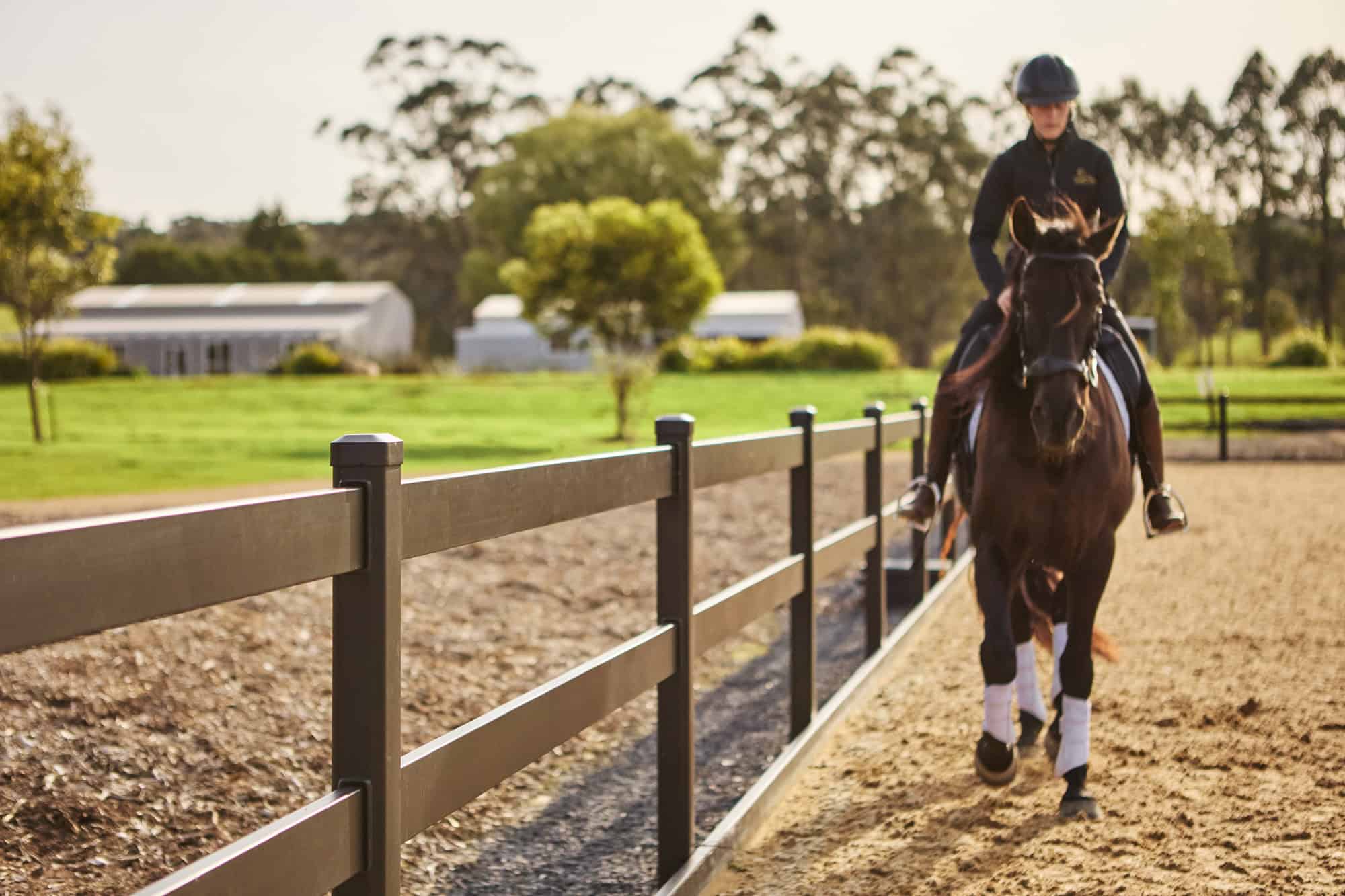Good horse care isn’t complicated, but it does require understanding the connection between physical safety, psychological security, and overall wellbeing. Whether you’re managing a single backyard companion or a barn full of performance athletes, the fundamentals remain surprisingly similar.
This guide walks you through the essentials of horse care with special attention to creating environments where horses truly thrive, not just survive.
Ask any experienced horse owner what they’d do differently if starting over, and most will tell you the same thing: “I’d have invested in proper fencing first.” It’s no coincidence that secure, appropriate boundaries form the cornerstone of horse care. Before the supplements, special blankets, or training equipment, horses need one thing above all else—a safe environment that works with their natural instincts rather than against them.
Horses are prey animals with flight responses hardwired into their DNA. When they feel secure in their surroundings, everything else about their care becomes easier: feeding, handling, healthcare, and training. We’ve seen it countless times: horses with proper boundaries are noticeably more relaxed, easier to manage, and experience fewer stress-related health issues.
It’s the difference between constantly fighting against their instincts and working harmoniously with them.
After all, the fence you choose isn’t just about keeping your horses in—it’s about creating the foundation for everything else you do with them. Let’s build that foundation right.
Creating a Safe Environment for Your Horses
The fancy supplements and premium grain don’t mean a thing if your horse is standing in an unsafe environment. We’ve pulled too many injured horses from dangerous situations to sugarcoat this: proper boundaries are the foundation everything else is built on. These animals spend 24 hours a day interacting with their environment, and they’re hardwired to constantly test its security.
When they’re uncertain about their boundaries, that anxiety shows up in everything from health problems to training issues.
After working with hundreds of horse properties, we’ve learned what separates safe setups from accidents waiting to happen:
- Visibility matters: Horses can’t respect what they can’t see. That’s why substantial horizontal rails create such effective psychological barriers. We’ve watched horses that blew through wire fencing like it wasn’t there stand respectfully behind proper split rail, never challenging it because they actually understand where the boundary is. Clear visual boundaries create confident, relaxed horses.
- Height and spacing aren’t one-size-fits-all: Standard 4-5 foot height with rails at roughly 18″, 36″, and 52″ works for most horses, but that Thoroughbred who thinks he’s an Olympic jumper might need different measurements. Know your horses and adjust accordingly—it’s cheaper than the vet bills from a botched escape attempt.
- Materials make all the difference: Ever bandaged up a horse that tangled with the wrong fence? Those smooth surfaces on quality rails prevent the lacerations we see with cheaper options. Flexible mounting systems absorb impact when your mare inevitably spooks at a blowing feed bag. These details matter when you’re dealing with 1,200-pound flight animals.
- Design around natural behaviors, not against them: Horses need to see their buddies, establish proper pecking orders, and move around naturally. Spaces designed against these instincts create stressed-out horses, period. We consistently see stereotypic behaviors like weaving and cribbing disappear when horses move to properties with thoughtfully designed containment systems that work with their nature rather than fighting it.
- Pay special attention to transition areas: The difference between an adequate setup and an excellent one often comes down to corners, gates, and transitions. These high-traffic areas need reinforced construction and careful planning. Rounded corners beat 90-degree angles when horses play or spook. Gates should swing completely out of traffic paths, not into them.
When evaluating your current setup, be brutally honest about what you see. Horses don’t just live within these environments: they lean on them, scratch against them, test them constantly. Every element needs to stand up to this daily abuse, not just look pretty in property photos.
Horse Care Essentials
Horses are remarkably durable animals when their basic needs are properly met. Most health issues stem from well-intentioned but misguided management rather than bad luck. With secure, appropriate boundaries in place, meeting these basic needs becomes a lot easier. You’ll spend less time chasing loose horses or repairing damaged fencing, and more time actually enjoying them.
- Water trumps everything else: A horse needs 5-15 gallons of clean water daily. No exceptions, no matter the weather. Strategic placement of water sources within your containment areas matters too. Position troughs where you can easily check and clean them, away from fence lines where horses might paw or play while drinking. Automatic waterers are worth every penny in time saved and consistent access.
- Feed for the horse you have, not the horse you want: Most pleasure horses are overfed and underworked. Quality forage should make up 1.5-2% of body weight daily, with concentrates added only when genuinely needed based on work level and metabolism. When you’ve invested in properly designed paddocks, you can implement slow-feeding systems that better mimic natural grazing patterns and reduce boredom behaviors.
- Daily checks prevent expensive surprises: The most valuable horse care habit is the two-minute walkaround. With safe, visible boundaries, you can quickly assess your horse’s movement, appetite, manure, and general demeanor without even entering the enclosure.
- Exercise isn’t optional: Horses evolved to move 10-20 miles daily. When they don’t, physical and mental health deteriorates rapidly. Well-designed containment systems allow for appropriate turnout even in challenging weather, unlike setups where you’re constantly worried about fence failures during play or seasonal conditions. If regular riding isn’t possible, ensure your paddock design allows enough space for natural movement.
- Routine maintenance prevents emergencies: Just like your truck needs regular oil changes, horses need consistent preventative care. Core vaccines, dental care every 6-12 months, and regular farrier visits (every 6-8 weeks for most horses) prevent expensive problems. Your containment system should facilitate easy catching and handling for these routine procedures.
Exercise & Turnout: Finding the Right Balance
There’s a world of difference between a horse that gets occasional turnout and one that lives in a properly designed space with appropriate freedom of movement. After fencing thousands of properties, we’ve seen firsthand how the right containment setup directly impacts a horse’s physical condition, mental state, and training responsiveness.
The Natural Movement Imperative
Horses are designed to move…constantly. Their digestive systems, joint health, respiratory function, and mental wellbeing all depend on regular, varied movement. When we restrict that movement with improper or insufficient turnout areas, we’re fighting against millions of years of evolution.
That fight inevitably shows up as health and behavior problems.
A horse confined to a stall for 23 hours daily, then frantically galloping during its brief turnout, is a recipe for both injury and behavior issues. Similarly, horses in tiny paddocks often develop repetitive movement patterns that create uneven wear on joints and hooves.
The ideal scenario allows for steady, natural movement throughout the day—something only possible with thoughtfully designed containment.
Design Matters More Than Size
We’ve seen 20-acre pastures that provide less effective exercise than well-designed 2-acre setups. The configuration of your space often matters more than its total square footage. Long, narrow paddocks encourage more movement than square ones. Strategic placement of resources (water at one end, hay at another) naturally encourages horses to travel throughout their space rather than camping in one spot.
Horses with multiple zones within their environment (sunny spots, shaded areas, sheltered spaces, and open ground) move between these areas naturally throughout the day. This varied movement is far healthier than forced exercise alone. Your fencing plan should create these distinct zones while maintaining safe, secure boundaries.
Managing Multiple Horses
When you’re dealing with more than one horse, containment design becomes even more important. Horses establish hierarchies that require sufficient space for lower-ranking animals to move away from dominant ones, especially during feeding. Split rail systems with appropriate sight lines allow horses to maintain visual contact without unsafe direct interaction when needed.
We often recommend paddock designs with connecting gates that allow flexible management—opening areas during good weather and limiting access during muddy seasons or when pastures need rest. This adaptability is only possible with properly planned, secure fencing systems that maintain their integrity through different configurations.
Balancing Freedom with Safety
The greatest challenge in horse keeping is providing enough freedom for optimal health while maintaining adequate safety. Cheap or poorly designed fencing forces owners to err on the side of restriction: keeping horses in smaller spaces because they don’t trust their containment system.
Quality fencing allows for appropriate freedom without constant anxiety about escapes or injuries.
This balance looks different for every horse. Young stock need more space for play and bone development. Senior horses benefit from gentle, consistent movement throughout the day. Performance horses require turnout that allows mental relaxation without injury risk before competitions.
Start Your Path to Better Horse Management
Proper horse care starts with creating secure, well-designed environments that work with your horses’ nature, not against it. The right boundaries don’t just contain your horses—they form the foundation for their overall health, behavior, and well-being.
We’ve spent decades helping horse owners transition from constant maintenance headaches to peaceful, secure properties where both horses and owners thrive. Whether you’re starting fresh or upgrading existing facilities, we’re ready to help you create the safe, functional spaces your horses deserve.
Contact us today to take the first step toward better horse management.



